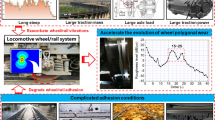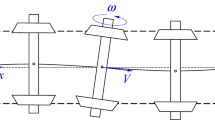Abstract
High-Speed Rolling Stock (HSRS) has the stability properties of closed-loop system dynamics, and the wear and abrasion of High-Speed Rails (HSR) are the sensitive factors to their evolution patterns. When considering the correlativity between the wear intensity of wheel-rail contact and the general mass of instability hunting oscillation, e.g. the primary/secondary hunting phenomena, the dialectical relations should be held within the track window for near-linear wheel-rail contacts so as to maintain hard the normal wear of wheel treads. Combined with some typical case studies, the full-vehicle stability properties and evolution patterns show that the self-stability of wheelset positioning under elastic constraints and the anti-hunting effectiveness of rotational resisting moments are the two important technical problems to cause the wear and abrasion of HSR. For some high-speed bogie configurations, the carbody yaw over-damped characteristics force the primary hunting phenomenon formed by both modes of rear bogie hunting and carbody rolling. Under the perturbations, like sidewind disturbances to carbodies or matching parameter variation of actual wheel-rail profiles, the primary hunting phenomenon is evolved to the secondary hunting one. As a result the high-speed carbody shaking phenomenon becomes one of important associated factors to the worn wheel-rail bad contacts. The anti-hunting absorbing wide-band mechanism solution was therefore proposed to instruct rightly the safe and comfortable design of high-speed bogies. With the improved high-speed bogies, Vlim = 480 km/h under λeN = (0.10–0.30), Max. 0.35 recommended, HSRS can be running on the extended routing crossover the different-graded lines.
Access this chapter
Tax calculation will be finalised at checkout
Purchases are for personal use only
Similar content being viewed by others
References
Zhou, Q.Y., Liu, F.S., Zhang, Y.H., et al.: Solutions for problems at wheel-rail interaction in high speed railway. China Railw. Sci. 38(5), 78–84 (2006). (in Chinese)
Aida, K., Tomioka, T., et al.: Development of displacement-dependent rubber bush for yaw damper to prevent carbody vertical vibration. Q. Rep. RTRI 58(3), 182–188 (2017)
Bruni, S., Belforte, P., et al.: Experimental investigation of yaw damper performances: an improved and harmonised testing methodology developed within ModTrain EU project. In: Proceedings of WCRR 2008 International Conference, Seoul (KR) (2008)
Piao, M.W., Yang, J., Liu, D.Z., Fang, J., Tian, D.M.: Design defaults of German ICE3 serial bogies and technical solutions. Comput. Integr. Manuf. Syst. 22(7), 1654–1669 (2016). (in Chinese)
Kaiser, I., Poll, G., Voss, G., Vinolas, J.: The impact of structural flexibilities of wheelsets and rails on the hunting behaviour of a railway vehicle. Veh. Syst. Dyn. 57(4), 564–594 (2019)
Nielsen, J.C.O., Johansson, A.: Out-of-round railway wheels-a literature survey. Proc. Inst. Mech. Eng. Part F J. Rail Rapid Transit 214(2), 79–91 (2000)
Mazzola, L., Alfi, S., Braghin, F., Bruni, S.: Limit wheel profile for hunting instability of railway vehicles. In: Proceedings of the Euromech 500 Colloquium: Non-smooth Problems in Vehicle Systems Dynamics, pp. 41–52. Springer, Berlin (2008). https://doi.org/10.1007/978-3-642-01356-0
Schoech, W.: New rail maintenance trends in Europe-anti-headcheck-profiles and preventive cyclical grinding. In: AusRAIL PLUS 2009, Adelaide, Australia (2009)
Esveld, C., Kok, A.W.M.: Interaction between moving vehicles and railway track at high speed. Rail Eng. Int. 27(3), 14–16 (1998)
Meirovitch, L.: Fundamentals of Vibrations. McGraw-Hill College (2001). ISBN 0-07-118174-1
Funding
This work was supported by National Key R&D Program of China [number 2017YFB0304605-3/2017YFB1201302-11].
Author information
Authors and Affiliations
Corresponding author
Editor information
Editors and Affiliations
Rights and permissions
Copyright information
© 2020 Springer Nature Switzerland AG
About this paper
Cite this paper
Du, W., Piao, Mw., Li, Gd., Yang, J. (2020). Hunting Phenomenon Evolution of HSRS and Anti-hunting Absorbing Wide-Band Mechanism Solution. In: Klomp, M., Bruzelius, F., Nielsen, J., Hillemyr, A. (eds) Advances in Dynamics of Vehicles on Roads and Tracks. IAVSD 2019. Lecture Notes in Mechanical Engineering. Springer, Cham. https://doi.org/10.1007/978-3-030-38077-9_38
Download citation
DOI: https://doi.org/10.1007/978-3-030-38077-9_38
Published:
Publisher Name: Springer, Cham
Print ISBN: 978-3-030-38076-2
Online ISBN: 978-3-030-38077-9
eBook Packages: EngineeringEngineering (R0)




